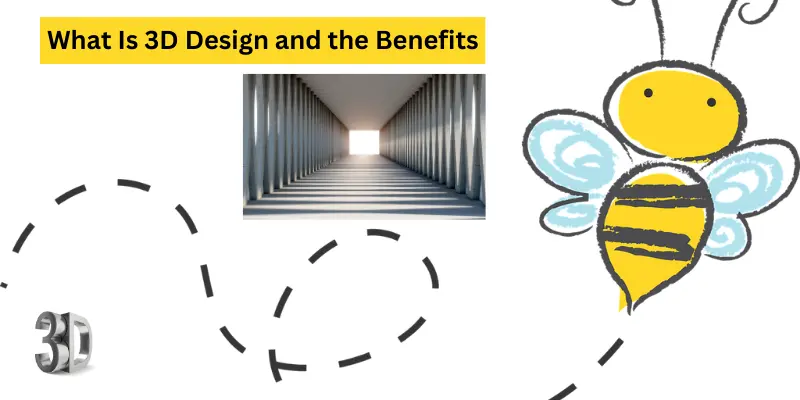What Is 3D Design and the Benefits | 3D Modeling?
Published: 02 Feb 2025
Introduction
In today’s digital world, 3D design has become a game-changer, transforming how we create and visualize objects. Whether designing a product, developing a game, or planning a building, 3D design and modeling offer endless possibilities. But what exactly is 3D design, and how can it benefit you? In this guide, we’ll dive into the basics of 3D design and explore its powerful advantages—from enhancing creativity to streamlining production.
Whether you’re a beginner or a professional, understanding 3D design is essential for staying ahead in today’s fast-paced, tech-driven world. 3d modelling

What Is 3D Design?
At its core, 3D design is the process of creating a digital version of an object that you can see from every angle, just like a real-life object. Using specialized software, designers craft 3D models that bring ideas to life in three dimensions—width, height, and depth. It’s like building a digital sculpture, but with tools that allow for endless creativity and precision. What is 3D Rendering?
How It Works:
To create a 3D design, designers use CAD (Computer-Aided Design) software or 3D sculpting tools to shape objects on a screen. These tools allow them to manipulate digital materials, adjust sizes, and add intricate details until the model looks perfect. The best part? The model can be rotated, zoomed in, and even “tested” in virtual environments before it’s brought to life in the real world.
Real-World Examples:
3D design is everywhere! Here are a few examples of where it’s commonly used:
Video Games:
Designers create the characters, environments, and objects that players interact with, giving life to virtual worlds.
Movies:
3D models help create visual effects and animated characters, from the dinosaurs in Jurassic Park to the superheroes in Marvel films. What is Apple 3D Touch on iPhone?
Product Prototypes:
Companies use 3D design to test products before they’re made. For example, designing a new phone or car model digitally before building the physical prototype helps save time and money.
Understanding 3D Modelling
What Is 3D Modeling?
3D modeling is the digital process of creating a three-dimensional object on a computer. It’s like building a virtual model of anything you can imagine—whether it’s a character, a building, or even an entire city. Designers use specialized 3D modeling software to craft these objects with incredible detail and accuracy. Popular tools like Blender, Autodesk Maya, and SketchUp help artists and engineers shape their designs in a digital space, allowing them to rotate, zoom in, and tweak the model from every angle before it’s brought to life.
Types of 3D Models
There are different ways to build 3D models, depending on the type of object and the desired level of detail. Here are a few common ones:
Polygonal Models:
These are made up of flat shapes (called polygons) that form the surface of the model, like a digital puzzle. Polygonal models are often used in video games and animation because they’re quick to create and easy to render.
NURBS Models:
NURBS (Non-Uniform Rational B-Splines) are smooth, curved surfaces used for highly detailed objects like cars and jewelry, where precision is key.
Sculpted Models:
Think of these as digital clay. Artists use tools to “sculpt” the model much like they would with physical materials, creating highly detailed, organic shapes. This method is often used in character design and visual effects.
Applications of 3D Modeling
3D modeling is incredibly versatile and used across many industries:
Game Design:
3D models bring characters, objects, and environments to life, from Minecraft blocks to detailed, realistic worlds in AAA games.
3D Printing:
Designs are turned into real-world objects by 3D printers, revolutionizing industries like healthcare (custom prosthetics) and manufacturing.
Virtual Reality (VR):
3D models create immersive, interactive environments where users can explore and interact in a completely virtual world.
Medical Imaging:
Doctors and scientists use 3D modeling to create accurate models of organs or complex surgical procedures, helping them plan and understand better than ever before.
Benefits of 3D Design and Modeling:
Creativity & Innovation
3D design opens the door to endless creative possibilities, allowing you to experiment with shapes, textures, and ideas without constraints. This flexibility helps bring unique concepts to life quickly and efficiently.
Efficiency & Cost Savings
By designing in 3D, you eliminate the need for expensive physical prototypes. You can test, modify, and perfect designs digitally, saving both time and money while speeding up the overall production process.
Precision & Accuracy
With 3D modeling, every detail is measured and adjusted digitally, ensuring high accuracy and precision. This minimizes errors, resulting in more reliable and well-executed designs.
Collaboration & Customization
3D models are easy to share, allowing for seamless collaboration with teams and clients. You can also make quick adjustments and personalize designs to meet specific needs, ensuring a more tailored end product.

Tools to Get Started with 3D Design
1-Blender: Free, powerful, and great for modeling, sculpting, and animation.
2-SketchUp: Easy, quick 3D modeling tool, perfect for architecture and design.
3-Tinkercad: Simple, web-based tool for beginners, great for 3D printing.
4-Autodesk Maya: Professional software for complex animation and visual effects.
5-Fusion 360: Ideal for product design and prototyping with precision.
6-ZBrush: Best for high-detail sculpting and character creation.
7-Rhinoceros: Accurate, precision-focused tool for engineering and architecture.
8 Cinema 4D: Great for motion graphics and animation with an easy interface.
- Which of the following is a popular free 3D design software?
a) Autodesk Maya
b) Blender 🟩
c) SketchUp
d) ZBrush - What is the main benefit of using 3D design in industries like product development?
a) It speeds up production and saves costs 💡💰
b) It only makes things look pretty
c) It requires no technical skills
d) It’s only useful for entertainment - What type of 3D model is typically used for creating highly detailed and organic shapes?
a) Polygonal Models
b) Sculpted Models 🪶
c) NURBS Models
d) CAD Models - Which of these tools is beginner-friendly for creating simple 3D models for 3D printing?
a) Blender
b) Autodesk Maya
c) Tinkercad 🖨️
d) Cinema 4D
How to Get Started with 3D Design and Modeling
Venturing into 3D design and modeling can feel overwhelming, but breaking it down into simple steps will make the process easier and more enjoyable. Here’s how to kickstart your 3D design journey:
Choose the Right Tool for You:
Picking the right software is crucial. Beginners can start with intuitive options like Tinkercad or SketchUp, which have easy learning curves. As your skills grow, explore more robust tools like Blender or Maya for advanced features.
Familiarize Yourself with 3D Concepts:
Before diving into complex designs, take time to understand core principles like 3D space, vertices, edges, and textures. This foundational knowledge will make navigating your software much smoother.
Start with Simple Models:
Don’t jump straight into intricate designs. Start by creating basic shapes like cubes, spheres, and pyramids to get comfortable with the interface and basic commands.
Build Your Skills Gradually:
As you gain confidence, challenge yourself with more complex projects—like designing household items or a basic character. The key is to steadily increase difficulty without overwhelming yourself.
Join a Community:
Connect with other aspiring 3D artists. Whether it’s on forums, social media, or design communities, engaging with others can provide inspiration, learning resources, and valuable feedback.
Use Tutorials and Online Courses:
There are tons of free and paid resources available. Platforms like YouTube, Skillshare, and CG Cookie offer tutorials for beginners and intermediate designers. Take advantage of these to learn specific techniques and shortcuts.
Iterate and Refine Your Work:
3D design is all about refinement. Don’t expect perfection on your first try. Keep revising your models, experiment with new techniques, and see how small changes can improve the overall design.
Create and Share Your Portfolio:
Once you’ve honed your skills, start building a portfolio. Showcase your best work, whether it’s in a 3D print or digital format, and use it to demonstrate your growing expertise.
Conclusion
3D design and modeling have revolutionized various industries, offering endless creative possibilities, precision, and efficiency. Whether you’re a beginner experimenting with basic shapes or a professional crafting complex virtual environments, mastering 3D design tools opens up opportunities in fields ranging from entertainment and product development to healthcare and architecture. By understanding the core concepts, leveraging powerful tools, and recognizing the tangible benefits, anyone can tap into the potential of 3D modeling to bring ideas to life in once unimaginable ways.
FAQs 🤖
To get started with 3D modeling, you’ll need a 3D design software (like Blender, SketchUp, or Tinkercad), a computer with decent graphics capability, and some basic knowledge of 3D concepts. Once you have these tools, dive into free tutorials and start experimenting with simple models to build your skills!
The time it takes to become proficient varies depending on the software you choose and how much time you dedicate to practice. As a beginner, it might take a few weeks to a couple of months to get comfortable with the basics. With regular practice, you’ll start creating more complex designs. Remember, consistent effort is key! 💪






